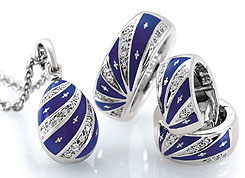The story of a legend
For millennia people have been adorning themselves with colorful accessories, made of precious metals, beset with jewels, and decorated with wonderful patterns. Nevertheless, few jewelers have succeeded in being associated with the perfection of their craft across several generations. Peter Carl Faberge, the son of French-German ancestors, ruled the world of jewels in the four decades prior to the outbreak of World War I.
On the following pages, you will hear the story of this legendary jewelry manufacturer, and you will experience the revival of that legend under workmaster VICTOR MAYER. In the museum we will show you some of the most exquisite and famous works of the house of FABERGÉ from the first Imperial Easter eggs to highly luxurious items for everyday use.
After the 1917 October Revolution, Faberge fled Russia. All of the assets of the Faberge company located within Russia had been confiscated by the new government. Peter Carl Faberge died in Lausanne, Switzerland in 1920.
Contemporary Faberge Jewelry
The famous jeweler to the Tzars, Peter Carl Faberge, used so called "Work masters" to create his wonderful objects of art. The Faberge Company, then in St. Petersburg, now has offices in London, Paris, and New York, to continue this tradition.
In 1990 the Faberge Company appointed the jeweler Victor Mayer GmbH & Co. of Pforzheim, Germany, founded in 1890, as the new and exclusive work master. This firm was chosen because throughout more than 100 years it has continued to maintain the essential manual skills and technical knowledge necessary for the continuation of Faberge's legacy. Under one roof 60 craftsmen exercise more than 30 traditional skills - some of them unique to this firm.
Victor Mayer of Pforzheim, Germany is the only Work master in the world that has been entrusted with the license to produce and sell Faberge Company enameled 18k gold jewelry. Every item created is an original work produced in a limited edition and bears the coveted "FABERGÉ" hallmark and the mark of work master Victor Mayer.
The family owned enterprise, Victor Mayer GmbH & C, was founded in 1890 and is one of Europe's leading producers of handmade jewelry. In more than 30 countries the name of the company founder is synonymous with the craft of the German goldsmith. Creations from Victor Mayer are the result of an unusual combination of tradition and innovation. Their greatest asset is an archive of designs, models, and workbooks as well as specialty tools and equipment from 110 years of company history. Thanks to the knowledge handed down to the fourth generation, the craftsmen at Victory Mayer are able to use rare techniques of the goldsmith's art to produce incomparable jewelry and objects of art for Faberge.

